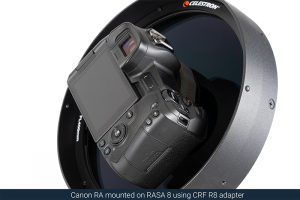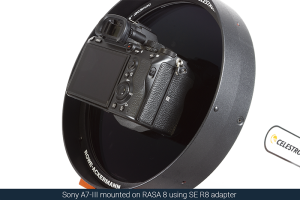Astrodevice Camera Adapters for RASA 8 offer two new adapters to attach cameras to the Celestron RASA 8 telescope: the Canon with EOS-R mount (such as the Canon Ra) and Sony with E-mount (such as the Sony A7-III). The adapters are made with the 3D printing technique using PET-G reinforced with carbon fiber. The construction has no additional calibration screws and manufacturing tolerance is 0.1 mm.
As the Astrodevice team notes, “The RASA 8 telescope was designed to guarantee ideal image quality up to APS-C format. Full-frame sensors are much larger than this. Therefore, when using full-frame cameras, you can expect vignetting of varying geometries, depending among other things on the design of the camera itself. For example, in Canon Ra cameras dedicated to astrophotography the vignetting takes on quite a classical shape but from the top and bottom an even, linear, darker framing is visible. Similarly, vignetting will occur in cooperation with other full-frame cameras (e.g. Sony).”
They continued, “This is quite normal, but it is good to know what you should expect. These darker areas can be corrected to some extent with flat frames and the remaining imperfections can be removed in post-processing, possibly by cropping the image to a slightly smaller format. This edge processing will also help to deal with the optical imperfections that appear when working with large sensors and small backfocus. In summary, full frame photography is entirely possible with the RASA 8 with Canon cameras with RF mount and Sony with E-mount, all you need is an Astrodevice adapter.”
Adapter for Canon RF-Mount Cameras and RASA 8
 The adapter is designed to connect Canon cameras with RF mount to RASA 8 telescopes. One of the most well-known of these types of cameras, the one dedicated for astrophotography, is Canon RA.
The adapter is designed to connect Canon cameras with RF mount to RASA 8 telescopes. One of the most well-known of these types of cameras, the one dedicated for astrophotography, is Canon RA.
The adapter is screwed directly onto the telescope using a large M87 nut. Thanks to the fact that the nut is integrated with the rest of the adapter, the camera is mounted perfectly centrally. However, you can still adjust the rotation angle as you wish.
The adapter has an internal thread for a 2″ filter. To use it you have to unscrew the glass window from the telescope, which is also recommended by the telescope’s manufacturer in their documentation when using any filters. As usual in similar situations, if you would like to shoot full spectrum, it is probably worth considering a UV/IR cut filter.
The device is made to keep the backfocus as close as possible to 28.73 mm, that is the distance from the front of the telescope to the camera sensor.
Adapter for Sony E-Mount Cameras and RASA 8
 If you use a Sony mirrorless camera (e.g. A7-III) you probably know how difficult it is to attach it to a RASA 8 telescope. To some it seems simply impossible for three different reasons. First, the RASA 8 telescope has a very short backfocus – the sensor must be 28.73 mm from the front of the telescope. The telescope doesn’t leave much room for connection. Secondly, the camera sensor is large and placed very close to the front edge of the instrument. Third, the camera housing leaves almost no room for the wide cap that the telescope requires.
If you use a Sony mirrorless camera (e.g. A7-III) you probably know how difficult it is to attach it to a RASA 8 telescope. To some it seems simply impossible for three different reasons. First, the RASA 8 telescope has a very short backfocus – the sensor must be 28.73 mm from the front of the telescope. The telescope doesn’t leave much room for connection. Secondly, the camera sensor is large and placed very close to the front edge of the instrument. Third, the camera housing leaves almost no room for the wide cap that the telescope requires.
However, it turns out that clever geometry can solve this difficult connection problem. The Astrodevice team has created an adapter that not only allows you to connect your mirrorless Sony to the RASA 8, but also allows you to screw in a 2″ filter, giving you a full-fledged set up for astrophotography work. In addition, the adapter is equipped with a special key that allows you to easily attach and remove the accessory from the camera.
To use the adapter you don’t have to calibrate anything – there are no adjustment screws and all you have to do is unscrew original glass window from front of the telescope. For those who would like to photograph in the fullest spectrum of light, it is recommended to put on a regular 2″ UV/IR filter.
You can learn more about the Astrodevice Camera Adapters for RASA 8 here.
 And to make it easier for you to get the most extensive news, articles and reviews that are only available in the magazine pages of Astronomy Technology Today, we are offering a 1 year magazine subscription for only $6! Or, for an even better deal, we are offering 2 years for only $9. Click here to get these deals which only will be available for a very limited time. You can also check out a free sample issue here.
And to make it easier for you to get the most extensive news, articles and reviews that are only available in the magazine pages of Astronomy Technology Today, we are offering a 1 year magazine subscription for only $6! Or, for an even better deal, we are offering 2 years for only $9. Click here to get these deals which only will be available for a very limited time. You can also check out a free sample issue here.

